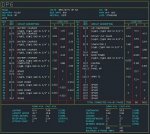You are using an out of date browser. It may not display this or other websites correctly.
You should upgrade or use an alternative browser.
You should upgrade or use an alternative browser.
Load split between circuits
- Thread starter Designer69
- Start date
- Status
- Not open for further replies.
jaggedben
Senior Member
- Location
- Northern California
- Occupation
- Solar and Energy Storage Installer
If it's line to line, it does not split. The entire 8320 Watts flows on both legs.
- Location
- Placerville, CA, USA
- Occupation
- Retired PV System Designer
Allocating half of the VA to each line is normal. And then after adding up all loads you use the 3 phase power equation to get the line current.If it's line to line, it does not split. The entire 8320 Watts flows on both legs.
Designer69
Senior Member
If it's line to line, it does not split. The entire 8320 Watts flows on both legs.
well it couldn't be 8320 Watts on both phase A and B right? that would be 16.64KW. So is it 8320W from phase A and 0 from phase B?
Designer69
Senior Member
Can't say for certain. With a neutral involved, it could be unbalanced.
can we assume it is perfectly balanced for now? I am just trying to get a better understanding for how it works.
Thank you
- Location
- New Jersey
- Occupation
- Journeyman Electrician
Don't you have 8320 watts on a two wire circuit?
jaggedben
Senior Member
- Location
- Northern California
- Occupation
- Solar and Energy Storage Installer
well it couldn't be 8320 Watts on both phase A and B right? that would be 16.64KW. So is it 8320W from phase A and 0 from phase B?
^ what infinity said.
You've said it's a line-to-line load. And you've asked us to assume that it's balanced, which means no current flowing on any neutral. That leaves you with two wires connected to the load, which is one circuit. All the power flows on that circuit.
Also strictly speaking each wire is not a phase. A phase is a combination of two wires. If the wires are black, red, blue, then the phases are black-red, red-blue, and blue-black. With a line to line load on two wires you are using one phase. Maybe that helps you understand.
Last edited:
If you add all three line totals, and the result is the average line current. Use single phase power formula on each individual line total to get approximated individual line current.Allocating half of the VA to each line is normal. And then after adding up all loads you use the 3 phase power equation to get the line current.
well it couldn't be 8320 Watts on both phase A and B right? that would be 16.64KW. So is it 8320W from phase A and 0 from phase B?
If you are doing this like a panel, adding up volt-amperes (VA; watts ÷ power factor) per line (A, B, C), then you use half the load VA per line.can we assume it is perfectly balanced for now? I am just trying to get a better understanding for how it works.
Thank you
To get a more accurate determination you'd have to vector sum load currents.
Fitzdrew516
Senior Member
- Location
- Cincinnati, OH
View attachment 14747
Refer to pic. I have a line to line load of 8320 Watts on a 120/208VAC panel 3phase as shown.
does the power split evenly between the 2 phases? so 4160W is taken from phase A and 4160W from phase B?
thank you
I think this may help you out and answer your question without getting over complicated. I think you are asking for a panel schedule as Smart suggested so refer to his answer, but here is a picture of a panel schedule of mine.
Take the "Rotary Cup Filler" in space 8,10,12 for example. The load for this piece of equipment is 16.63 KVA. You'll see the load split between A,B and C to the right at 5.54 each. Hope this helps!
Attachments
Designer69
Senior Member
I think this may help you out and answer your question without getting over complicated. I think you are asking for a panel schedule as Smart suggested so refer to his answer, but here is a picture of a panel schedule of mine.
Take the "Rotary Cup Filler" in space 8,10,12 for example. The load for this piece of equipment is 16.63 KVA. You'll see the load split between A,B and C to the right at 5.54 each. Hope this helps!
thanks for the explanation. Although I'm surprised your calculated load is higher than your connected load. Isn't calculated load basically your demand load?
kwired
Electron manager
- Location
- NE Nebraska
Connected load is what is physically connected. Calculated load may have demand factors applied to it or portions of it.thanks for the explanation. Although I'm surprised your calculated load is higher than your connected load. Isn't calculated load basically your demand load?
There are also minimums to calculated load, such as lighting per square foot calculating out to more than the connected load.thanks for the explanation. Although I'm surprised your calculated load is higher than your connected load. Isn't calculated load basically your demand load?
- Status
- Not open for further replies.


